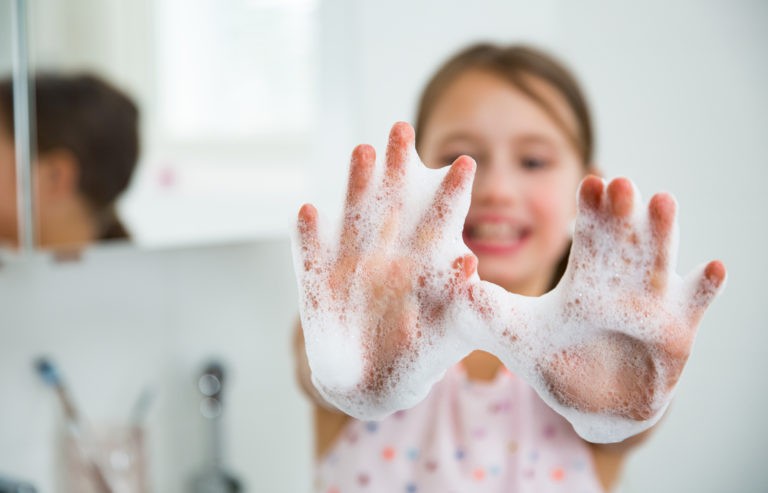Importance of Teaching Kids About Germs
The COVID-19 pandemic has made the spread of disease a daily conversation in households across the world. Although schools, playgrounds, and parks are often germ hotspots, children may not understand how germs spread and how important it is to limit the spread of germs to stay healthy. If they aren’t taught these things, they can not only become sick, but they can unintentionally spread their illness to family and friends. We don’t want kids to be afraid, but we do want them to be aware, so teaching kids about germs and hygiene is important to help them live a healthier life and help to keep their loved ones healthy as well.
Projects to Do at Home to Learn About Germs
GermBalls
Read the book Germs by Ross Collins with your kids; then bring the germs in the book to life! All you will need is either cotton balls (variety of sizes) or craft pom-poms to create GermBalls for this activity. Put the GermBalls in your child’s hand and ask them to hold their open hands (palm up) close to their face. Ask your child to watch the GermBalls as they whisper “Pox” (the name of the main character in the book), then ask if the GermBalls moved. Ask your child to say Pox again, once in a normal voice and then louder. Finally, ask your child to say Pox, but this time with the inside of their elbow covering their mouth. Have a discussion about how the GermBalls moved as they said Pox and relate it to how germs can be spread just by talking.
Germ Says
Blue painter’s tape is all you will need to represent germs in this activity. Tell your kids that you are going to play a game that’s like Simon Says, but it’s called Germ Says. Put a pieces of blue painter’s tape on the end of each of your child’s fingers and tell them that every time they do what Germ Says, they have to leave the piece of tape on whatever they touch. Then give them a series of actions to perform that all involve them touching their face and things multiple people in the home touch, but do this in traditional Simon Says fashion (i.e., Germ says turn the doorknob; Germ says flush the toilet; Germ says turn on the light; Turn off the light – Germ didn’t say to turn off the light!).
After all of the tape has been placed, talk about how the germs are everywhere and how easy it was for them to get there. Then play another round, but this time your child adds a piece of tape to their fingers for everything they touch. To end the game, Germ says to “wash your hands for 20 seconds.” Your child does not actually have to wash his/her hands, but must take a full 20 seconds to remove all of the tape from their fingers. Then talk about how easy it is to get rid of germs just by washing your hands.
Glitter Germs
You may want to do this activity outside! Pour a little bit of glitter into your child’s hands and tell them that each piece of glitter is a germ. Tell them to wave their hands and then look at them. Ask if all of the germs are gone. Then have them rub their hands together and ask if they still have germs. Have them wipe their hands on their shirt or shorts and again ask if they see any germs. Finally ask your child to wash his/her hands and discuss how the only way to get rid of the germs is to wash them away.
Germ Painting
Put different color finger paints on a paper plate and tell kids the paint represents germs. Have kids put their hand in the paint and then put their hand on a piece of paper. Allow the paint to dry and then have kids decorate their germs. Talk to kids about how the germs they touched on the plate transferred to the paper and did not go away.
Germy Kisses
Put icing, chocolate, peanut butter, or other spreadable and edible items on your child’s lips (like lipstick). Ask your child to kiss a piece of paper several times in different spots. When the lip prints are barely visible have your child go back and kiss the first lip print. They should notice that their lips are still “germy.” Allow your child to lick or wipe their mouths. Talk about how important it is to keep things away from their mouths because germs can stick to their lips.
Real Germ Research
Show your child pictures of real germs and find age-appropriate articles or books about germs that you can read together. Kids can draw a picture and write 1-3 sentences about germs based on what you read. Older children can do their own research about germs and then create a short public service announcement about how germs spread and how to stay safe.
Making sure our children are informed is one way to help stop the spread of germs! Seek out resources that are relatable, but that clearly explain that we don’t want to share germs with the people we love.




